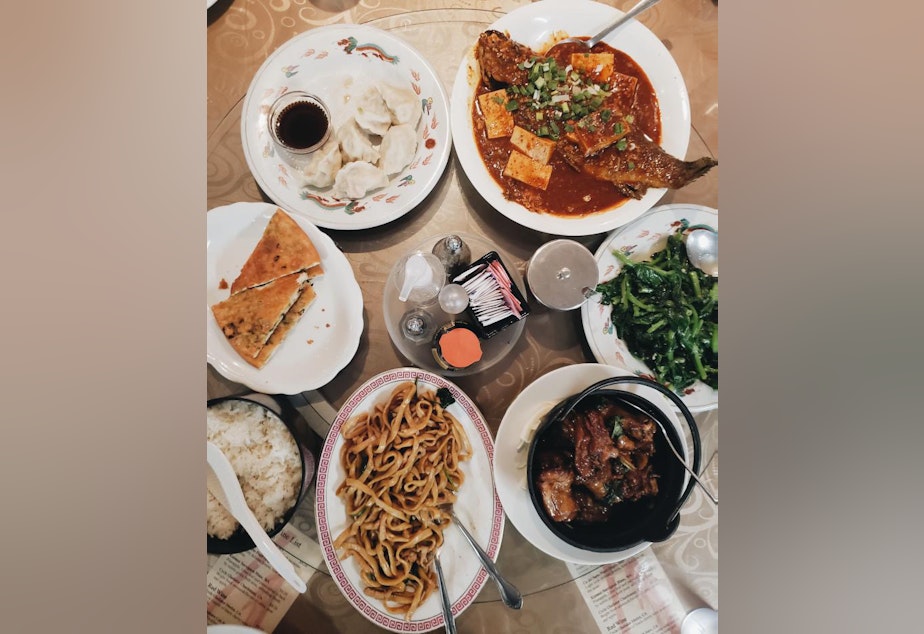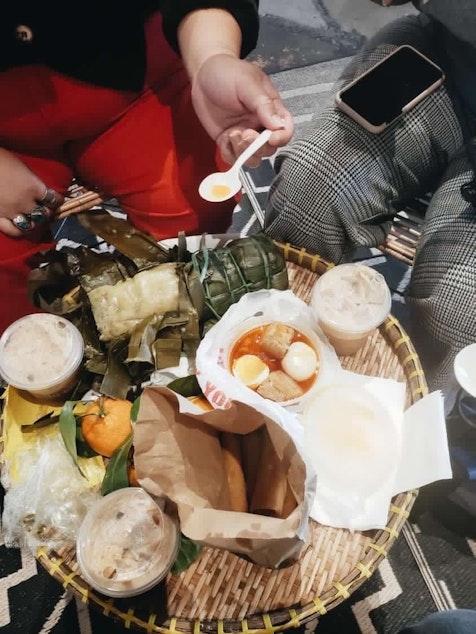Lunar New Year: forging connection and community, one bite at a time

Lunar New Year celebrations continue this week in many parts of the world. It’s a time to reconnect with family and loved ones — something that may feel especially poignant with the recent string of violence in California.
Whether it’s through sharing joy or giving comfort, food plays a central role during Lunar New Year celebrations.
Soundside producer Noel Gasca reached out to a few local chefs about the Lunar New Year dishes that hold a special meaning to them.
Tết
Tết marks the arrival of spring based on the Vietnamese Calendar.
To celebrate, I grabbed some friends, and we went for a feast. Our first stop was to Saigon Vietnam Deli for Thịt Kho Trứng, coconut braised pork and eggs in a vibrant orange-red colored broth. We grabbed Chả giò from Spring Roll House Deli, and we picked up bánh tét from Hau Hau Supermarket.
Bánh tét is a Lunar New Year rice cake, and it's made with sticky rice and filled with mung beans and pork, and is wrapped in a banana leaf.
Trinh Nyguen is the chef of Ba Sa Restaurant on Bainbridge Island, and she told me about how each ingredient in bánh tét has a special meaning.
"The banana leaf, which is an abundant ingredient that we have in Vietnam, it represents all the green, colorful things that we have in our country," Nyguen said.
She went on to tell me that the sticky rice represents a whole year of fullness, and the meat represents plentifulness.
"The only way you had meat to eat, you know, in our country back back in the days is if you had money. So they are wishing basically everything for you: plentiful fullness."

Chinese New Year
From our Tết experience in Little Saigon, my friends and I turned our journey — and our stomachs — to Chinese New Year.
We headed up to Chiang’s Gourmet on Lake City Way. After my friends and I sat down at our table, we told our server, Cindy Chang, that we were looking for Chinese New Year foods. She immediately started offering suggestions.
With Cindy’s recommendations, we ended up ordering scallion pancakes, pork dumplings, noodles, greens in a garlic sauce, and a whole fish.
"For Chinese, we always have fish, with the tail, with the head. That means the whole fish, the whole family," Chang said.
We had to make sure to add boiled dumplings to our order too, because their shape — round like gold coins — brings good fortune for the new year.
Cindy said she takes the day off for Chinese New Year, and gets together with her family. Usually they eat and play cards. But before that can happen, Cindy said they have to take care of another tradition.
"We have to do like a spring clean, we have to clean the house really well," Chang said. "So that kind of motivates kids to do things."
Seollal
I also got the rest of the Soundside team to join me in trying some of the dishes you enjoy during Seollal, which is the Korean name for the Lunar New Year.
The main dish you eat during Seollal is tteokguk, a rice cake soup in beef broth.
Rachel Yang is a Seattle-based chef, and she runs two restaurants here in the city: Joule and Revel. She filled me in about the meaning behind this soup.
"You don't age unless you eat tteokguk. That's what you're told that since you're very little, so you have to eat tteokguk in order to get older, " Yang said. "And obviously when you are young — when you’re children — you just want to get old you know, so people don't eat ... just one serving of tteokguk."
The rice cakes are shaped like tiny coins, and the more "coins" in your tteokguk, the more you will prosper for the rest of the year.
In the midst of a tragedy, healing through food
The options for a truly delicious Lunar New Year meal are limitless. It was really fantastic to hear from some local chefs, restaurant workers, and even my friends about how much they look forward to this time of year.
There are a ton of great options here in Seattle and beyond to try Lunar New Year dishes — go have a meal with your family and friends.
But there’s another thing: with the recent mass shootings in Monterey Park and Half Moon Bay, and their impacts on Asian American communities, I was feeling unsure of whether it was OK to talk about something as happy as food.
But then I reached out to Rachel Yang — the chef who explained about tteokgeok — and she sent me this message:
It does seem trivial to talk about food when people's lives are lost. However, the holiday food is not just food, but a vessel to bring the community together. It may have more meaning to share the rice cake soup that can comfort each other.
I think food can be a big source of comfort for some people right now, and Rachel’s message reminded me that in the midst of a tragedy, it can be healing to sit across from someone and simply share a meal.




